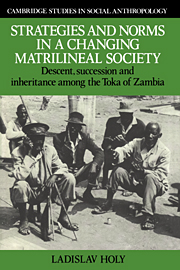 Strategies and Norms in a Changing Matrilineal Society
Strategies and Norms in a Changing Matrilineal Society Book contents
- Frontmatter
- Contents
- List of maps and diagrams
- List of tables
- Acknowledgements
- Introduction
- 1 Descent categories and local ties in traditional Toka society
- 2 Technological development and the restructuring of the relations of production
- 3 Changing norms of inheritance
- 4 The structure of local groups
- 5 The changing concept of the basimukowa
- 6 Mukowa and ritual
- 7 The role of the mukowa in succession
- 8 The role of the mukowa in inheritance
- 9 Mukowa: representational and operational models
- 10 Norms as a strategic resource
- Appendix 1 Village fission in Guta
- Appendix 2 Aspects of individual mobility in Ngwezi
- Notes
- References
- Index
- Cambridge Studies in Social Anthropology
4 - The structure of local groups
Published online by Cambridge University Press: 25 August 2009
- Frontmatter
- Contents
- List of maps and diagrams
- List of tables
- Acknowledgements
- Introduction
- 1 Descent categories and local ties in traditional Toka society
- 2 Technological development and the restructuring of the relations of production
- 3 Changing norms of inheritance
- 4 The structure of local groups
- 5 The changing concept of the basimukowa
- 6 Mukowa and ritual
- 7 The role of the mukowa in succession
- 8 The role of the mukowa in inheritance
- 9 Mukowa: representational and operational models
- 10 Norms as a strategic resource
- Appendix 1 Village fission in Guta
- Appendix 2 Aspects of individual mobility in Ngwezi
- Notes
- References
- Index
- Cambridge Studies in Social Anthropology
Summary
One of the important consequences of the introduction of new agricultural technology and the resulting restructuring of the relations of production in Ngwezi has been a decrease in the inter-village mobility of the male population. This has led to considerable changes in the social composition of existing villages.
Individual mobility
My study of individual mobility in Ngwezi is based on a census of 119 married, divorced, or widowed men and 134 married, divorced or widowed women in twelve villages. To indicate the changes which have occurred, I compare it with individual mobility in Cifokoboyo, whose analysis is based on a census of 114 married, divorced, or widowed men and 120 married, divorced or widowed women in eleven villages in that area.
At the time of the census, sixteen women in Ngwezi resided in their natal villages. Nine of them had never left the village in which they were born and another seven returned to it after they had temporarily established residence elsewhere. (In Table 2 women who had moved back to their natal villages appear as residing in their third or fourth village.) It is quite typical that a divorcee returns to the village of her parents, which does not necessarily have to be her natal village. It is sometimes a village into which her parents (or her mother) have themselves moved from the village in which she was born.
Information
- Type
- Chapter
- Information
- Strategies and Norms in a Changing Matrilineal SocietyDescent, Succession and Inheritance among the Toka of Zambia, pp. 88 - 117Publisher: Cambridge University PressPrint publication year: 1986